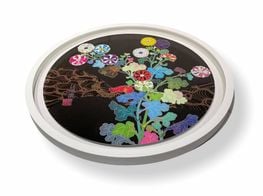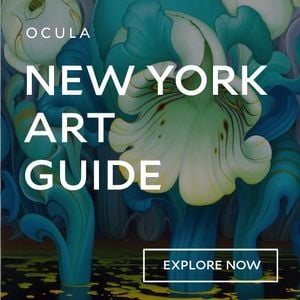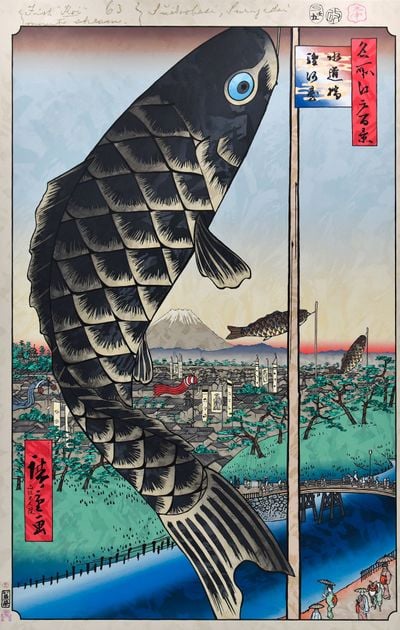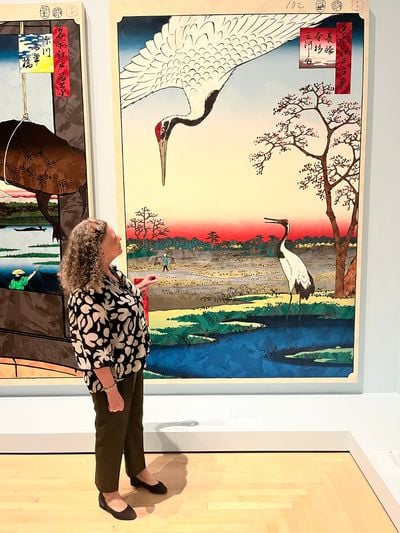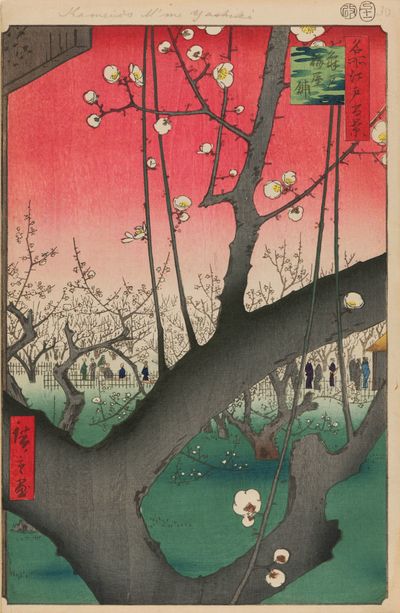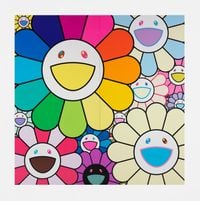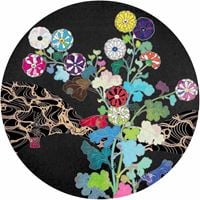How Murakami Hurried Out 120 Works for Brooklyn Museum Show
The prolific Japanese artist adapted woodcut prints by ukiyo-e master Utagawa Hiroshige, who himself created some 8,000 works in his lifetime.
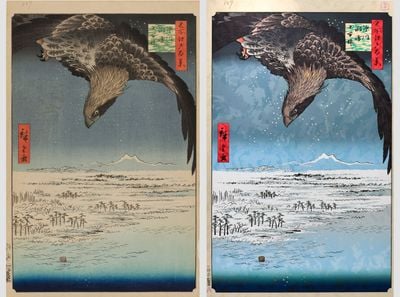
Left: Utagawa Hiroshige, Fukagawa Susaki and Jūmantsubo (Fukugawa Susaki Jūmantsubo), no.107 from '100 Famous Views of Edo', 5th month of 1857. Woodblock print. Brooklyn Museum. Photo: Brooklyn Museum. Right: Takashi Murakami, Hiroshige's 100 Famous Views of Edo: Japonisme Reconsidered—Fukagawa Susakiand Jūmantsubo (2024). Acrylic on canvas mounted on wood panel, 350 × 227.5 cm. © 2024 Takashi Murakami/Kaikai Kiki Co., Ltd. All Rights Reserved. Courtesy of the artist and Gagosian.
Takashi Murakami barely finished his screen prints in time for the opening of Hiroshige's 100 Famous Views Of Edo (feat. Takashi Murakami), which opened at the Brooklyn Museum on 5 April.
'These are brand new and in many cases it's a miracle that the ink's dry,' Joan Cummins, the museum's Curator of Asian Art, told Ocula when the exhibition first opened. 'He finished these about a week ago.'
It's the first-ever showing of 120 new works by the Japanese artist, who completed the entire set in just five months.
Murakami created the works to accompany a showing of the Brooklyn Museum's complete set of 100 Famous Views of Edo by 19th Century Japanese ukiyo-e master Utagawa Hiroshige.
Substituting silk screens for Hiroshige's wood blocks, Murakami recreated the entire set, altering the size, sprucing up the colours, and adding texture and some playful accents.
From a distance, Murakami's 10-foot-tall silk-screened version of Plum Estate Kameido, no. 30 (1857), for example, appears to be an identical (though greatly enlarged) copy. But look closer and you'll see textures resembling brush strokes or palette knife work, tiny sparkles of light, and infusions of brighter colours and shading.
The artist who coined the term 'Superflat' evidently wanted to add a bit of depth.
In several pieces, Murakami clearly had some fun. In his rendering of Minowa, Kanasugi, Mikawashima, No. 102 (1857), he added a tiny cartoon monster who peers up from a small grassy island in the work's lower left hand corner. Similar creatures appear in most of the larger Murakami pieces.
'Murakami and Hiroshige share many similar characteristics in their approach to creating art. Both are "idea people" who are unapologetic about employing others to help carry out their vision,' Cummins explained.
Hiroshige created a remarkable 8,000 works before he died at 61. Working across painting, sculpture, fashion, merchandise, and animation, Murakami, at 62, has been similarly prolific.
'Team production allowed both artists to create large bodies of work in relatively little time, but hiring multiple assistants or fabricators comes with a significant cost. For Hiroshige, this cost was seen as a worthwhile investment that would pay off in strong sales. In Murakami's case, past success has allowed him to invest in current projects, regardless of their potential profitability,' she added.
Murakami was also drawn to Hiroshige because of the profound influence he had on European artists, especially Vincent van Gogh.
'One of the main things he knew about Hiroshige was that Van Gogh copied Hiroshige. He admits that when he looks at Hiroshige he's often looking through a filter of Van Gogh. You would think he's Japanese, he grew up with Hiroshige, but no, he can't escape that Van Gogh approach,' Cummins said.
In the case of Plum Estate Kameido, no. 30, Murakami's is the second noted copy. Van Gogh's was the first.
Hiroshige's 100 Famous Views Of Edo (feat. Takashi Murakami) continues through 4 August.

